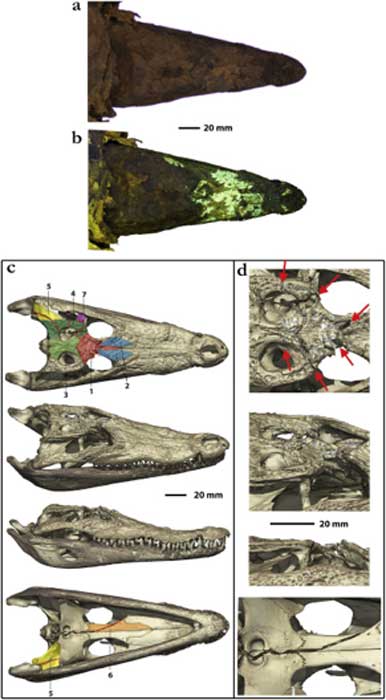
Did Ancient Egyptians Actively Hunt Crocodiles for Mummification?
Scans of a 2,000-year-old crocodile suggest the reptile was hunted for mummification rites.
Mummified animals have been recovered from many, if not most, ancient Egyptian tombs and while today we love cuddling up to our pets, few of us regard them as divine. Back then, animals were important spiritual conduits communicating between humans and their gods and each one was symbolic of or associated with a different deity. Mummification processes required a constant supply of animals - which included trapping wild animals, collecting loyal domesticated pets, and also breeding animals specifically for mummification rites.

Crocodile mummy for the god Sobek, Ptolemaic-Roman Period - Field Museum of Natural History (Opacity/ CC BY NC-ND 2.0)
Now, a new paper published in the Journal of Archaeological Sciences by a team of researchers led by Stéphanie M. Porcier of France’s Université Paul-Valéry Montpellier III suggests crocodiles were actively “hunted for mummification”. One crocodile specimen was discovered by archaeologists excavating the Upper Egyptian city of Kom Ombo during the early 20th century and now, using a technique called synchrotron scanning, the paper determines that the reptile was “sneaked up on” and smashed on the head, fracturing its skull.
- 2,500-Year-Old Mummified Crocodile Yields Surprises
- Sobek, the Crocodile God Who Sweated the Nile While Creating the World
- Archeologists Discover Ancient Burial Site of Infants, Scorpions and Crocodiles

The crocodile mummy. (Porcier et al.)
Clubbed to the Afterlife
Dr. Porcier and her researchers wrote in the paper that the size and direction of the fracture suggest the killing blow was delivered with a thick wooden club “aimed at the posterior right side of the crocodile,” while the creature was resting. The study also says that the hunter or trader began the crocodile’s mummification process soon after its death by covering the wound in the skull and treating it with oils and resins before wrapping it in linen sheets.

Photo of the head and 3D rendering showing the lethal skull fracture. (Porcier et al.)
The crocodile is one of about 2,500 animal mummies kept at the Musée des Confluences in Lyon, France, and in the scientists’ press release it says advanced imaging technology provided a virtual autopsy of the mummified beast. This new analysis determines that the animal was a 3 to 4-year-old juvenile male measuring about 3.5 feet (1.07 meters) long. And Michael E. Ruane wrote in the Washington Post that foods found in the creature’s stomach at the time of embalming included reptile eggs, fish, a rodent, and large insects.

Photo and 3D rendering of the crocodile mummy. (Porcier et al.)
This One Ate a Cow
It is not known whether this hunted crocodile is evidence of a nationwide practice, and the scientists write that future studies might lead to a “reconsideration of mummy suppliers animal procurement processes.”
A 2016 Ancient Origins article covered the story of a three-meter-long (9.84 ft.) crocodile mummy that was eventually discovered as being two large crocodiles wrapped-up together, and a 3D CT scan showed that this mummy also contained “dozens of individually wrapped baby crocodiles.” The British Museum, working with the UK's Royal Veterinary College, scanned this crocodile revealing that its last meal may have been a cow, as bovine bones were discovered inside its stomach.
In ancient Egypt, the god of the Nile was worshipped by the cult of Sobek, a powerful fertility god depicted as a deity with the head of a reptile and the body of a man. As patron of the city Crocodilopolis, known in Egyptian as “Shedet”, the most impressive center of this cult was located in Kom Ombo, a twin temple in southern Egypt about 50 km (31.07 miles) north of Aswan, and this one and the recently studied crocodile mummy were two of about 300 discovered at Kom Ombo.
Possibly a Petsuchos
Last October I wrote an Ancient Origins news article about the discovery of ancient stone carvings, engravings, and paintings at Kom Ombo during a groundwater-lowering project in Aswan. A Live Science article informs that this impressive ‘twin’ or double temple at Kom Ombo is situated about 30 miles (48 km) north of Aswan and was built during the Greco-Roman period between 332 BC and 395 AD. While one temple was dedicated the falcon-headed god Horus the second was a sanctuary of the crocodile-headed god named Sobek.
- Discovery of Crocodile Carving Sheds Light on Political Rift Between Two Related Centers in Ancient Mexico
- Impressive Collection of Statuettes Depicting Ancient Gods Discovered in Egypt
- Crocodilian Teeth, Stingray Spines and Puma Skulls All Discovered in One Ancient Maya Royal Tomb
The cult of Sobek first appeared during Egypt’s Old Kingdom and the distinctive temple dedicated to Sobek at Crocodilopolis contained a sandy stretch of beach, a lake, and a live Nile crocodile called Petsuchos (son of Sobek).
Petsuchos was the earthly manifestation of Sobek and worshipped with precious gemstones and gold, fed the finest meats, grains, wines, and milk mixed with honey. Upon his eventual death, Petsuchos was ritually mummified and his place was taken with another crocodile, leaving archaeologists wondering how many of the 300 mummies, and if this recently studied one, were possible past ‘Petsuchos’.

This relief from the Temple of Kom Ombo shows Sobek with typical attributes of kingship, including a was-scepter and royal kilt. The ankh in his hand represents his role as an Osirian healer and his crown is a solar crown associated with one of the many forms of Ra. (Hedwig Storch/CC BY SA 3.0)
The researchers have used state of the art technology to better understand mummification processes and worship of Sobek, but they are still struggling with how to tell the difference between an alligator and a crocodile. However, they suspect one was always “seen later” while the other one was always “in a while”.
Top Image: Research indicates Nile crocodiles were hunted specifically for crocodile mummification rituals. Source: quasarphotos / Adobe Stock
By Ashley Cowie















